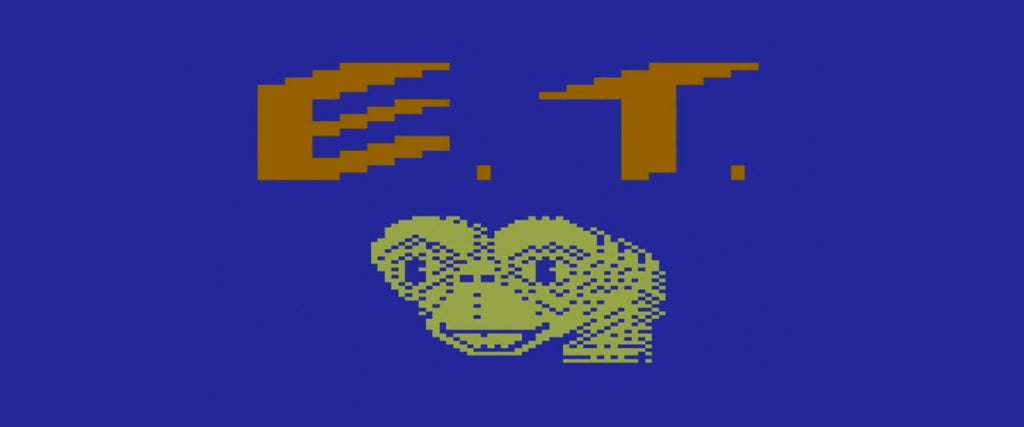In 1982, Shannon was 7 years old. Back then, she loved two things above all else: video games and E.T. the Extra-Terrestrial. And so, when Christmas rolled around, much like thousands of other kids, the new E.T. game for the Atari 2600 was at the top of her wishlist. She was desperate to have it. After all, it was the hot toy of the year. “There was a TV ad that had E.T. dressed up as Santa Claus,” she says. “The cover of the game had Henry Thomas (Elliott) and E.T. on it, which I suppose made people think it would somehow be just like the movie.”
That Christmas morning, her family beamed as Shannon opened the gift. “I’ll never forget how excited they were to see me open the game and watch me play it,” she tells me. Her excitement, however, quickly turned into teary-eyed disappointment: “I played for about a half hour before I finally gave up. I even had the adults in my family try.” Her mom agreed that it was just too complicated. “I remember her saying, ‘This doesn’t make any sense. What is the plot? What are you supposed to do?’” Shannon says. “In those days, there weren’t many detailed directions, and you were pretty much on your own. There was certainly no internet or YouTube to get tips.”
Her Christmas was ruined by what is now commonly thought of as the worst video game ever made. “It is the worst Atari game ever made and that platform had a LOT of schlock,” says Jake, who got an Atari 2600 along with a bundle of games that included E.T. around the same time Shannon did. “The only positive I can give the game is that you learned that movie tie-in games were never good.”
He has numerous complaints about the game, but he was primarily baffled by the play style. “An 8-year-old just wants to shoot things, and when you were playing E.T., you were running from the scientist instead of shooting. Why do I have to extend E.T.’s neck? Why do I ‘float’ out of a huge hole? I don’t remember any of this being in the movie. You could have had a game where you just flew in a bike with Elliott and shot at government agents with your glowing finger dick. That’s all the game had to be. Fuck everyone involved, they got what they deserved.”
The main man involved — Howard Scott Warshaw, who designed the E.T. game as well as Yars’ Revenge and Raiders of the Lost Ark, two of Atari’s most popular titles — was blissfully unaware of the backlash for weeks after it debuted. All he knew was that initial sales had been gangbusters, and that he’d received royalty checks indicating continued success. But in late January and February 1983, people from sales and marketing started giving him a different impression. “They’d say things like, ‘You really came through for us, nice work. We don’t really blame you,’” he tells me. “And I was thinking, ‘I don’t know what the hell they’re talking about.’”
Although the game sold 1.5 million copies over the Christmas season, eventually between 2.5 million to 3.5 million copies were sent back to Atari, a combination of unsold stock and returns. By the end of 1983, the E.T. game would be cited as one of the causes for the collapse of Atari. This was a far cry from the excitement at the company just six months earlier when they had acquired the highly sought after licensing rights to the movie. The catch, however, was that they had just five weeks to finish it.
According to Warshaw, a typical game at that time took about six months to develop. Thus, just 36 hours after agreeing to do it, Warshaw was on a jet pitching Steven Spielberg his initial concept — a treasure hunt-style game that followed elements of the movie, namely E.T phoning home. Spielberg signed off on the idea, and the countdown clock began. “I can honestly say that all the way through, I was both confident and scared out of my mind,” Warshaw says. “But the reason I was confident was because I understood one critical factor in the whole process — the key to doing a game in five weeks was creating a design that could be achieved in five weeks. I needed to come up with something I could do in that time frame and then see how good of a game I could make out of that.”
Building on the idea he had pitched to Spielberg, Warshaw’s plan was to make a game that had few rules but as many outcomes as possible. Essentially, E.T. would collect phone parts, so that he could phone home. He then had to rush to a forest location in order to meet his mothership. The phone parts were hidden in pits that would become the game’s most reviled flaw and the cause of some mild childhood trauma. That’s because falling into the pit was very easy, but getting out could be very difficult.

Warshaw agrees that the pits were a problem he didn’t foresee. Unfortunately, he was in such a rush to finish the game he never got to the “first playable” stage, which is when a game is tested by users to work out any design kinks and flaws. “The way I had the pits configured, any part of E.T. that touches any part of the pit makes you fall into the pit,” Warshaw explains. “The challenge was being able to run around the screen and negotiate them and not fall in when you didn’t want to, and to know how to work your way around falling back in when you’re coming out of the pit.” Most users assumed you had to touch the pit with E.T.’s feet to fall in, but they were wrong and subsequently paid the price.
After the pits, the other main complaint about the game was that it was confusing; people would just give up, something Warshaw has thought about a lot in retrospect. “I wish I had the resources to put in on-screen directions, but they were pretty much unheard of at that time,” he says. “I could have had very brief written tips, hints to help you navigate the game. That would have made a huge difference.”
Geoffrey Golden is a narrative designer in L.A. and even a gaming obsessive like him was confused by the game. “E.T. was my first time really being confused, then annoyed, then upset at a video game,” he says. “It reaffirms the importance of play testing. If Atari hadn’t rushed the game for Christmas, and skipped play testing, player feedback would’ve almost certainly told the programmer to go back to the drawing board,” he says. “In this way, E.T. serves as a cautionary tale to developers against pumping out a lot of garbage really fast and expecting people to buy it. The game is also part of a legacy of terrible licensed games, which has made many players skeptical of licenses in general.”
The idea of E.T. being the ”worst game ever,” however, is a relatively new concept, fueled by internet hater culture that began in the early aughts. Warshaw finds some of the recent criticism unfair, namely the idea that the game is what brought down Atari. “Atari spent $22 million on a property, knowing they were going to have a very short deadline. They never talked to the development people. They never even asked what was possible until after they finished negotiating the deal and signed the contract,” he says. “So the most expensive property in history at the time got the shortest development schedule in history. Is this a good way to run a company?”
Adding to the legend that E.T. destroyed Atari was a rumor that the company literally buried its greatest failure in a desert landfill in New Mexico. Legend has it that hundreds of thousands of unsold cartridges were placed in the ground and covered with cement, a claim so legendary it was the subject of the documentary Atari: Game Over. “Once they started digging, yes they found E.T. cartridges,” Warshaw says. “But there were Raiders of the Lost Ark cartridges, too. There were Centipede cartridges. Every top-selling Atari game was there.”
Still, Warshaw mostly takes the hate in stride, although he does occasionally confront it with a simple question: “I always ask, ‘Have you ever played it?’ You’d be amazed how many people who come up and say this to me haven’t actually played the game. Not every opinion is an informed opinion, but you know, we live in a world now where opinions have turned into facts.”
Golden agrees that the disdain may be a little over-the-top. “I think E.T. is a bad game technically, but I don’t know that it’s leaps and bounds worse than other terrible Atari games,” he says. “But since it was way overhyped at launch, and helped cause the video game crash of 1983, yeah, I think it belongs in that ‘worst’ conversation.”
Of course, the internet being the internet, the game has also developed a nostalgic following, too — sort of an anti-haters crowd. Rob, a software developer and video game history buff, informs me that some members of the gaming community have even fixed the major issues with it. “They added a ROM hack that recoded some of the most annoying parts of the game (including the fact that E.T.’s color is off). The biggest fix, though, was to the pit problem. What makes the game insufferable is that if even one pixel on the top of E.T.’s head touches a pit, he falls down it.”
As for Warshaw’s involvement, well, he left game development altogether to become a therapist. “I’ve moved on to a much more sophisticated hardware — the human brain,” he jokes. He even credits the disaster that was the E.T. game for inspiring his career change. “One of the things that might’ve moved me to become a therapist in the first place was to find a way to actually address all the trauma and depression I created,” he tells me.
Warshaw is, though, currently working on a book about his experience, cheekily titled Once Upon ATARI: How I Made History by Killing an Industry, that should be finished soon and released shortly thereafter. Overall, he is remarkably good humored about the whole ordeal. “I see it this way,” he tells me. “E.T. is always on the all-time worst lists. But my other big game, Yars’ Revenge, is almost always on the best lists. That means I have the greatest range in video game history.”

